
Petey (the Pig) Forge: one of several NYC pigs the city has threatened to “dispose of”
The pig is an iconic off-beat urban pet, and definitely illegal in New York City.
Brittany Murphy’s manic pixie dream girl character in Uptown Girls keeps one in her apartment, and former Mayor Bloomberg’s daughter brought her fat familiar into Gracie Mansion in 2012 for Thanksgiving. Over the past few years several more non-fictional New Yorker porcine pets have been brought out of the woodwork as part of an ongoing campaign to lift the citywide ban.
New York State Senator Avella asks “why not” keep a pig for a pet, if the animal is properly trained? The Health Department says pigs can’t be vaccinated for rabies. The pigs’ people say their pigs are “gentle” and “clean” and “brought joy back” to their grieving family.
What these debates tend to miss is that pigs have been a favorite animal companion of New Yorkers for centuries — almost reaching back to the birth of the city. But people’s relationship to their domestic swine was a bit different back then, as was their relationship to metropolis.
1819: People v. Harrison
At the start of the 19th century, metropolis was pretty gross:
[I]n a world without professional streetcleaners, a world in which private citizens were expected to provide the manpower (the term in this context a misnomer) to remove the excrement and the wastes of urban street life, pigs assumed a necessary public role, particularly in wards whose residents lacked available servants. The result was, we might imagine, a peculiar urban ecological cycle, one which connected residents with their physical environment in a way that is difficult for us to imagine today. In brief, people ate pigs, and pigs ate the human and animal wastes and garbage which lined the streets of the city.
That’s from “Pigs and Positivism”, a paper published in the Wisconsin Law Review in 1985 about New York’s historical attitude towards hogs. As the author, Hendrik Hartog, illuminates, pigs used to be an important part of the American urban ecosystem, and that urban ecosystem was foul. Garbage and sewage were both dumped out of windows and into the street. This is one reason why etiquette dictates (and Emily Post advised) “A gentleman […] takes the curb side of the pavement” — there were historically many hazards street-side, both from the gutter below and the windows above.
From the gutter, they ran into the local bodies of water. New Yorkers were so desperate for clean water by the beginning of the 19th century that Aaron Burr was able to scare up funds for a company to provide the island with clean water. But he abandoned that project as soon as the ink was dry — in an almost comically dastardly move, he’d included a secret clause in the company charter that let him use that money to start a bank instead. Of $2 million raised, he spent a mere $1,000 on water infrastructure. The rest went into a bank that eventually became JPMorgan Chase. It was only after decades of cholera outbreaks — a disease spread by fecal contamination of food and water — and thousands of deaths, that the city established a real water system in 1842.
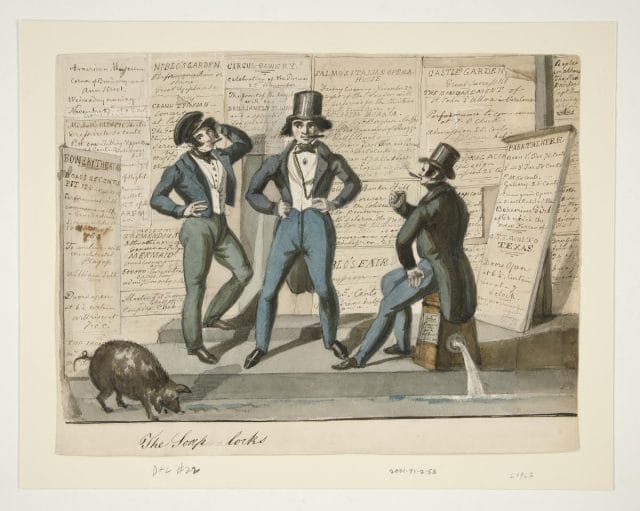
1847 watercolor of working class New Yorkers
Hartog wrote, “Traditionally, public services and goods had been a by-product of the commercial life of the community,” — i.e. rich boroughs and successful business districts had the funds to at least attempt to have their waste removed. According to the Encyclopedia of Consumption and Waste, in many American cities mid-century, “Ad hoc systems of waste removal developed, using both private contracts (mainly for businesses and wealthy neighborhoods) and public agents, which rarely offered comprehensive community-wide programs. Water collection was thus organized according to class and social standing.” For the rest of urban America, there were pigs. The food waste and human waste that ended up choking the streets of New York were, in essence, hog heaven. As for human heaven, Hartog reminded readers, pigs are where bacon comes from.
“Not only was the pig ‘our best scavenger,’ a street cleaner for parts of the city which badly needed cleaning but which were ignored by municipal employees, but it also provided cheap food for the poor in winter.”
But not every one was on-board with piggy New York City. Pigs had their drawbacks, and didn’t quite fit the many people’s vision of a distinguished and prosperous city. The snootier visiting European aristocrats looked down upon them, and included them in their watercolors, (the more open-minded visiting European aristocrats saw them as an American novelty, and also included them in their watercolors.)
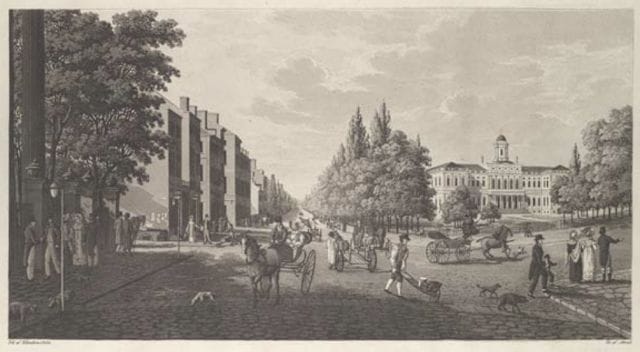
Swedish baron Alex Klinckowström’s “Broadway Street and the City Hall in New York”, 1820
Soon, regulations started piling against the urban swine. The first — in 1809 — required that roaming pigs wear nose rings to discourage them from rooting up cobblestones. Then in 1817 an ordinance passed in 1816 allowed any person to bring any pig on the street to the pound. “If the pig’s owner wanted it returned, he or she would have to pay ten dollars to the person who ‘captured’ the pig plus charges of twelve cents per day to the pound,” Hartog wrote.
In 1818, New York’s Mayor Cadwallader Colden empanelled a grand jury on the pig question, which then indicted two individuals with the misdemeanor of ‘keeping and permitting to run hogs at large in the city of New York.’ One of the accused offered no defense and was charged a nominal fine. The other, a butcher named Christian Harriot, hired attorneys and was tried on January 5, 1819, “on the question of whether he could be convicted of maintaining a public nuisance because he owned pigs that were sometimes found on city streets.”
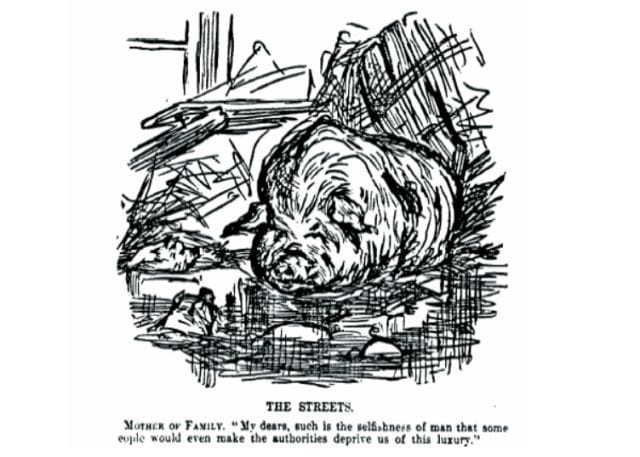
Cartoon from Harpers 1880, “My dears, such is the selfishness of man that some people would even make the authorities deprive us of this luxury.”
The district attorney prosecuted the case, the mayor presided, and the grand jury convicted the butcher. What was the prosecutor’s case? Hartog characterized it as a “series of horror stories […] to show the evils of pigs in the streets,” and listed examples:
“(1) hogs attacked children,
(2) boys got into trouble by riding hogs,
(3) ladies had been compelled to view swine copulating in open view,
(4) hogs defecated on people.”
Those are some hilarious and pretty nasty negative externalities. When put that way, it’s no wonder that some people might’ve preferred filthy streets to free-roaming hogs, even at a cost to their health. Don’t feel too bad for Harriet, the defendant — he was only fined a dollar, and Mayor Coldwell made a point of of admitting that the city had implicitly licensed him to keep his pigs on the streets, “and that exonerates him from any immoral intent.” Coldwell was likely trying avoid being seen as waging a war on the poor. But in his jury charge he also laid the ideological foundation for modern civics. As Hartog wrote:
“What was the pigless city he imagined? A city whose cleanliness and health — the public good — would be produced by a paid bureaucracy, rather than through the more or less compulsory involvement of citizenry in corporate governance.”
Of course, as is usually the case with ideological foundations, the actual infrastructure didn’t spring up for several decades. And they continued to keep pigs in plain sight. As late as 1848 a man attempted to sue the city for damages after a streetpig killed his son (he lost). In 1842, Charles Dickens published his American Notes for General Circulation, and brought the bands of feral pigs under the scrutiny of his pen — Five Points, a lower borough of Manhattan, being one of the most-offensive neighborhoods:
“This is the place [Five Points], these narrow ways, diverging to the right and left, and reeking everywhere with dirt and filth. Such lives as are led here, bear the same fruits here as elsewhere. The coarse and bloated faces at the doors have counterparts at home, and all the wide world over. Debauchery has made the very houses prematurely old. See how the rotten beams are tumbling down, and how the patched and broken windows seem to scowl dimly, like eyes that have been hurt in drunken frays. Many of those pigs live here. Do they ever wonder why their masters walk upright in lieu of going on all-fours? and why they talk instead of grunting?”
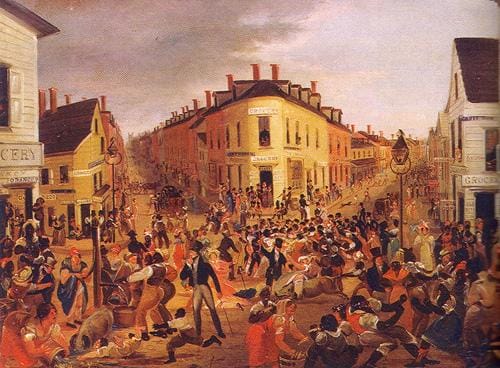
Five Points, as painted by George Catlin in 1827
Like with the water system, the impetus for finally quelling the pig problem was cholera. After the cholera epidemic of 1849, Hartog says a campaign was initiated “under the color of municipal emergency which identified [pigs] as filth producers.” By June the police had confiscated 5,000-6,000 pigs. “Thereafter,” Hartog wrote, “if numbers of pigs remained in the city, their presence in the streets had become surreptitious and unambiguously ‘criminal.’”
Penned Pigs, Past and Present
The battle against penned pigs was a longer one. Immigrant families kept piggeries — they would collect slaughterhouse and street waste, sell what they could, and feed the rest to pigs they would sell to local butchers. The most organized effort to get rid of these (admittedly unattractive, and foul-smelling) piggeries, was called the “Piggery War” of 1859, and drove urban agriculture underground for the next century.

“Urban agriculture was hardly respected in nineteenth-century New York,” says Catherine McNeur, professor of history at Portland State, “– a far cry from our current embrace of backyard chickens and rooftop beehives.”
Another part of Mayor Coldwell’s charge to the jury in People v. Harriet, was that his vision for a pigless city as “radically separated” from the countryside, and economically robust enough that its poor that had enough cash income to buy their food, instead of raising it — basically prophesizing urban modernity. In the 19th century, agriculture was driven into the country and the city was cleansed of what Coldwell called “the disgusting spectacle of animals indulging in the propensities of nature.” It has taken a hundred and fifty years for farming to creep back in. The new urban agriculture is eking out space in a new New York — a city with, among other things, skyscrapers and a sweage system.

In any case, proponents of New York pig ownership have argued that the fashionability of urban agriculture is irrelevant to their cause: they view their pigs as family members, not four-legged bacon factories. And they’re a very different animal than the hogs that terrorized the slop-drowned streets a hundred and fifty years ago.
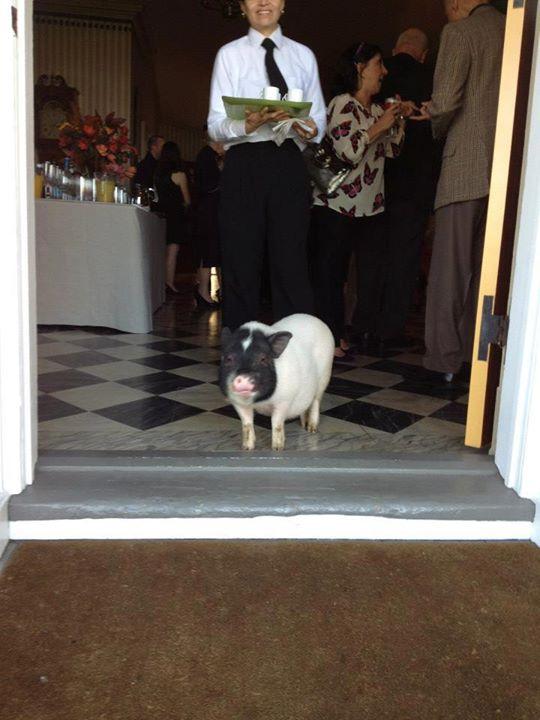
Georgina Bloomberg’s pet pig Wilbur, at Gracie Mansion on Thanksgiving, 2012
“[Senator Avella] doesn’t agree with the city’s classification that pigs are farm animals,” State Senator Tony Avella’s communications director told a reporter this summer. “Pigs are domesticated and clean, hypoallergenic, and they aren’t all that big, they are not bigger than your average midsized dog.”
The Piggery War might have been fought and lost in 1859, but the Pet Pig War of the 21st century wages on.
This post was written by Rosie Cima; you can follow her on Twitter here. To get occasional notifications when we write blog posts, please sign up for our email list



